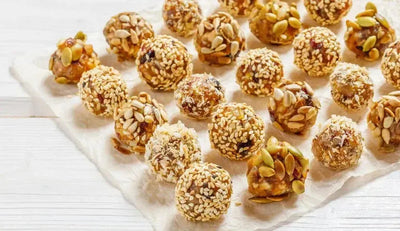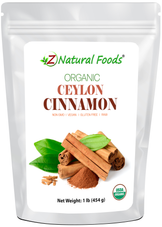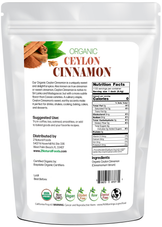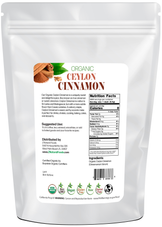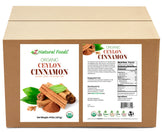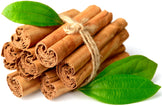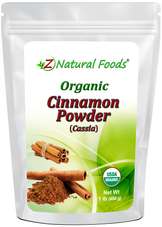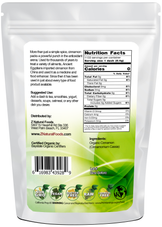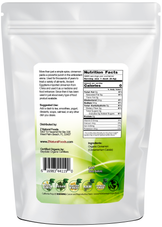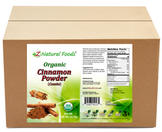Description
Description
As we enter the fall season, there's no better time to embrace the warm, comforting flavors of autumn. And among the most beloved of warm and comforting spices, cinnamon stands out as a true favorite.
While there are four main types of cinnamon, today we focus on Ceylon and Cassia. Ceylon and Cassia cinnamon share obvious similarities but they have different characteristics in terms of flavor, aroma, and chemical composition.
Each type has its own unique properties and compounds, but collectively they have made cinnamon a truly remarkable spice that has withstood the test of time.
Let's dive into the world of Ceylon and Cassia cinnamon, explore their unique qualities and why they're perfect for your culinary adventures not just this fall season, but long after.
The Tale of Two Cinnamons; Ceylon and Cassia Cinnamon
Z Natural Foods’ cinnamon comes in two varieties: Ceylon (Cinnamomum verum) and Cassia (Cinnamomum cassia).
While both offer that quintessential cinnamon flavor we all know and love, they have distinct characteristics that set them apart.
Ceylon Cinnamon: The True Cinnamon
Often referred to as "true cinnamon" or Mexican cinnamon, Ceylon cinnamon hails from Sri Lanka.
Ceylon is prized for its delicate, sweet flavor with subtle notes of citrus. The bark is lighter in color and has a softer texture compared to its Cassia counterpart.
Z Natural Foods offers an exceptional Organic Ceylon Cinnamon Powder that captures the essence of this premium spice.
Ceylon cinnamon is perfect for those who appreciate a more nuanced cinnamon flavor in their fall recipes.
Cassia Cinnamon: The Bold Classic
Cassia cinnamon, on the other hand, is what most Americans think of when they hear "cinnamon."
Cassia has a stronger, more pungent flavor and is darker in color. Cassia is the type you'll most commonly find in grocery stores.
For those who love a robust cinnamon kick, Z Natural Foods' Organic Cassia Cinnamon Powder delivers that classic, intense flavor that pairs perfectly with fall comfort foods.
Why Cinnamon is Fall's Favorite Spice
There's a reason cinnamon is synonymous with autumn. Its warm, sweet aroma evokes memories of cozy kitchens and holiday gatherings.
But beyond its nostalgic appeal, cinnamon offers several benefits that make it an ideal spice for the fall season:
- Warming Properties: As temperatures drop, cinnamon's warming nature can help you feel cozy from the inside out, making it perfect for chilly autumn days. A splash of cinnamon in tea, coffee or other hot drink can give you an upgrade while delivering a tasty, spicy kick.
- Possible Immune Support: Fall marks the beginning of cold and flu season. Cinnamon has been shown to have unique properties that may contribute to supporting a healthy immune system response. A review in the journal Nutrients highlighted cinnamon's possible potential to be used as a natural alternative for food preservation to retard or inhibit the bacterial growth of pathogenic and spoilage bacteria[11].
- Possible Blood Sugar Support: With holiday treats around the corner, cinnamon might help keep your sweet tooth in check. Research published in Diabetes Care suggests that cinnamon may support healthy blood sugar control in people with type 2 diabetes. The research found that consuming 1, 3, or 6 grams of cinnamon per day reduced fasting serum glucose levels by 18-29% in participants with type 2 diabetes, suggesting that cinnamon may indeed support healthy blood sugar control[12].
- Antioxidant Powerhouse: A study in the Journal of Agricultural and Food Chemistry found that cinnamon had higher antioxidant activity compared to other spices. This study found that in a comparative study among 26 spices, cinnamon showed the highest antioxidant activity, indicating that it can be applied as an antioxidant used in foods[13].
The Active Compounds in Cinnamon: A Scholarly Overview
Cinnamon, derived from the inner bark of trees belonging to the genus Cinnamomum, has been used for centuries as a spice and traditional medicine.
Modern scientific research has identified several bioactive compounds in cinnamon that contribute to its potential health benefits.
Let’s briefly review the most significant active compounds found in cinnamon, focusing on their chemical structures and potential biological activities.
Cinnamaldehyde
Cinnamaldehyde is the primary active compound in cinnamon, responsible for its characteristic flavor and aroma.
Chemically, it is an organic compound with the formula C6H5CH=CHCHO. Studies have shown that cinnamaldehyde possesses various biological activities.
Cinnamaldehyde may have antimicrobial properties and has shown effectiveness against various pathogens[11]. Studies also indicate that cinnamaldehyde can modulate inflammatory pathways, potentially benefiting conditions involving inflammation[3]. Additionally, some studies suggest cinnamaldehyde may help improve insulin sensitivity and glucose metabolism[12].
Research also suggests cinnamaldehyde possesses antioxidant properties, which may contribute to its overall health effects[13] and studies have explored cinnamaldehyde's potential in relation to neurological conditions[3].
Cinnamic Acid
Cinnamic acid, a phenolic compound with the formula C6H5CH=CHCOOH, is another important bioactive component of cinnamon.
It is known for its potential antioxidant properties, potential to possibly inhibit some diseases, and may have some antibacterial properties against various pathogens[3].
Eugenol
Eugenol, a phenylpropene with the chemical formula C10H12O2, is present in cinnamon oil and contributes to its biological activities, which may include analgesic properties. Eugenol has been shown to have pain-relieving effects in some studies[14] and like other phenolic compounds in cinnamon, eugenol exhibits strong antioxidant properties[15].
Coincidentally, eugenol is the most abundant and important compound in cloves, another key fall spice, and is responsible for the characteristic aroma of cloves and has been extensively studied for its potential biological activities. Go here for more information about our Organic Clove Powder.
To read more about Cloves and the unique compounds go here for an excellent article in our blog:
Discover the Perfect Autumn Spice: Organic Clove Powder
Proanthocyanidins
Cinnamon bark contains oligomeric proanthocyanidins, which are complex polyphenolic compounds. Proanthocyanidins in cinnamon are important for several reasons.
Cinnamon proanthocyanidins exhibit strong antioxidant activities, which contribute to the spice's overall beneficial effects.
These compounds in cinnamon are more complex than previously thought, containing various subunits that may explain some of cinnamon's unique properties.
Cinnamon bark proanthocyanidins include a mixture of different types, contributing to their varied effects. The activities of cinnamon proanthocyanidins suggest possible uses in food preservation and as dietary additions. Proanthocyanidins play a role in protecting cinnamon plants against environmental stresses.
Coumarin
While not considered beneficial, coumarin is a notable compound found particularly in Cassia cinnamon. It's important to mention due to its potential hepatotoxicity when consumed in large amounts[3]. Ceylon cinnamon contains much lower levels of coumarin compared to Cassia cinnamon. Different cinnamon varieties contain varying levels of coumarin:
- Ceylon cinnamon (Cinnamomum verum) contains very low levels (0.004%)
- Cassia cinnamon (Cinnamomum cassia) can contain up to 1% coumarin [16]
Cinnamon contains a complex mixture of bioactive compounds, with cinnamaldehyde, cinnamic acid, eugenol, and proanthocyanidins being among the most significant.
These compounds contribute to cinnamon's potential health benefits, including antioxidant, anti-inflammatory, antimicrobial, and potential antidiabetic effects.
However, it's important to note that while in vitro and animal studies show promising results, more human clinical trials are needed to fully understand the health impacts of these compounds when consumed as part of the human diet.
The synergistic effects of these compounds in whole cinnamon extract may be more beneficial than isolated components, as suggested by some studies[6].
This highlights the importance of considering the complex phytochemical profile of cinnamon in its entirety when evaluating its potential health benefits.
Popular foods to make with your with Ceylon and Cassia cinnamon
Now that we understand the unique qualities of Ceylon and Cassia cinnamon, let's explore how to use them in your fall cooking.
The options here are nearly endless. And when combined with your Organic Apple Powder, Organic Clove Powder, and your Organic Pumpkin Powder, your choices expand even more!
3 ways to use Ceylon Cinnamon: The Subtle Sophisticate
Z Natural Foods' Organic Ceylon Cinnamon Powder shines in delicate dishes where you want a hint of cinnamon without overpowering other flavors. Try it in:
- Apple cider: Add a pinch to your homemade apple cider for a refined twist.
- Pumpkin spice latte: Use Ceylon for a delightful pumpkin spice blend.
- Baked pears: Sprinkle over baked pears and your favorite fruit for an incredible dessert.
- Very popular choice for sprinkling on yogurt, oatmeal, coffee, smoothie and your favorite foods.
3 ways to use Cassia Cinnamon: The Bold Flavor Enhancer
For recipes that call for that classic cinnamon punch, reach for Z Natural Foods' Organic Cassia Cinnamon Powder. It's perfect for:
- Cinnamon rolls: Create the ultimate fall breakfast treat to go with your tea or coffee.
- Spiced nuts: Toss with roasted nuts for a savory-sweet snack.
- Chili: A pinch of cassia cinnamon can add depth to your favorite chili recipe.
Quality Matters: Choosing the Right Cinnamon
When selecting cinnamon, quality is key. Both Z Natural Foods' Ceylon and Cassia cinnamon powders are organic, ensuring you're getting pure, high-quality spice without any additives or pesticides.
It's worth noting that while both types of cinnamon may offer health benefits, Ceylon cinnamon contains less coumarin, a compound that can be harmful in large doses. If you're a cinnamon enthusiast who consumes it regularly, Ceylon might be the better choice for daily use.
Embrace the Flavors of Fall with Cinnamon
As we welcome the cooler months, let's celebrate the versatility and warmth of cinnamon. Whether you prefer the subtle sophistication of Ceylon or the bold intensity of Cassia, Z Natural Foods has you covered with these premium organic offerings.
This fall, why not experiment with both types in your cooking?
From morning oatmeal to evening desserts, cinnamon can add that perfect touch of autumn magic to your meals. So grab your favorite mug, sprinkle in some cinnamon, and savor the flavors of the season.
Remember, when it comes to cinnamon, a little goes a long way. Start with small amounts and adjust to your taste.
Here's to a delicious, cinnamon-spiced autumn!
References:
[1] Wang, Yi Chun, Vinchi Wang, and Bing Huei Chen. "Analysis of Bioactive Compounds in Cinnamon Leaves and Preparation of Nanoemulsion and Byproducts for Improving Parkinson's Disease in Rats." Frontiers in Nutrition 10 (2023): 1229192. https://www.ncbi.nlm.nih.gov/pmc/articles/PMC10433916/.
[2] Gilani, Saeedeh, and Ghasem Najafpour. "Evaluation of the Extraction Process Parameters on Bioactive Compounds of Cinnamon Bark: A Comparative Study." Biochemical Engineering Journal 179 (2022): 108333. https://www.sciencedirect.com/science/article/abs/pii/S1359511322000289.
[3] Rao, Pasupuleti Visweswara, and Siew Hua Gan. "Cinnamon: A Multifaceted Medicinal Plant." Evidence-Based Complementary and Alternative Medicine 2014 (2014): 642942. https://www.ncbi.nlm.nih.gov/pmc/articles/PMC4003790/
[4] Shen, Yixiao, Wenjun Zhu, Huiwen Shi, Jiayi Feng, Xiaoqian Wang, Yongqiang Cheng, and Yao Wang. "Cinnamon: A Multifaceted Medicinal Plant—A Review." International Journal of Food Science 2023 (2023): 5467342. https://onlinelibrary.wiley.com/doi/10.1155/2023/5467342.
[5] Ranasinghe, Priyanga, Shehani Pigera, GA Sirimal Premakumara, Priyadarshani Galappaththy, Godwin R. Constantine, and Prasad Katulanda. "Medicinal Properties of 'True' Cinnamon (Cinnamomum zeylanicum): A Systematic Review." BMC Complementary and Alternative Medicine 13, no. 1 (2013): 275. https://onlinelibrary.wiley.com/doi/10.1155/2014/642942.
[6] Ribeiro-Santos, Regiane, Mariana Andrade, Nathália Ramos de Melo, and Ana Sanches-Silva. "Use of Essential Oils in Active Food Packaging: Recent Advances and Future Trends." Trends in Food Science & Technology 61 (2017): 132-140. https://www.sciencedirect.com/science/article/pii/S1756464622001153.
[7] Sri Lanka Export Development Board. "Difference Between Cassia and Ceylon Cinnamon." Accessed October 7, 2024. https://www.srilankabusiness.com/blog/difference-between-cassia-and-ceylon-cinnamon.html.
[8] National Center for Complementary and Integrative Health. "Cinnamon." Last modified July 2020. https://www.nccih.nih.gov/health/cinnamon.
[9] Z Natural Foods. "Organic Ceylon Cinnamon Powder." Accessed October 7, 2024. https://www.znaturalfoods.com/products/cinnamon-powder-ceylon-organic.
[10] Z Natural Foods. "Organic Cassia Cinnamon Powder." Accessed October 7, 2024. https://www.znaturalfoods.com/products/cinnamon-powder-cassia-organic.
[11] Nabavi, Seyed Fazel, Arianna Di Lorenzo, Morteza Izadi, Eduardo Sobarzo-Sánchez, Maria Daglia, and Seyed Mohammad Nabavi. "Antibacterial Effects of Cinnamon: From Farm to Food, Cosmetic and Pharmaceutical Industries." Nutrients 7, no. 9 (2015): 7729-7748. https://doi.org/10.3390/nu7095359.
[12] Khan, Alam, Mahpara Safdar, Mohammad Muzaffar Ali Khan, Khan Nawaz Khattak, and Richard A. Anderson. "Cinnamon Improves Glucose and Lipids of People With Type 2 Diabetes." Diabetes Care 26, no. 12 (2003): 3215-3218. https://doi.org/10.2337/diacare.26.12.3215.
[13] Su, Liangli, Jing-Jing Yin, Diane Charles, Kequan Zhou, Jeffrey Moore, and Liangli (Lucy) Yu. "Total Phenolic Contents, Chelating Capacities, and Radical-Scavenging Properties of Black Peppercorn, Nutmeg, Rosehip, Cinnamon and Oregano Leaf." Food Chemistry 100, no. 3 (2007): 990-997. https://doi.org/10.1016/j.foodchem.2005.10.058.
[14] Esmaeili, Fariba, Masoumeh Zahmatkeshan, Yaser Yousefpoor, Gholamreza Esmaeili, Seyed Mahdi Rezayat, Mehdi Amiri, and Reza Faridi-Majidi. "Anti-inflammatory and Anti-nociceptive Effects of Cinnamon and Clove Essential Oils Nanogels: An In Vivo Study." BMC Complementary Medicine and Therapies 22, no. 1 (2022): 149. https://doi.org/10.1186/s12906-022-03619-9.
[15] Khalil, Ali A., Ur Rahman, Muhammad R. Khan, Muhammad Sahar, Shahzad Mehmood, and Marwa Khan. "Essential Oil Eugenol: Sources, Extraction Techniques and Nutraceutical Perspectives." RSC Advances 7, no. 52 (2017): 32669-32681. https://doi.org/10.1039/C7RA04803C.
[16] Blahová, Jana, and Zdeňka Svobodová. "Assessment of Coumarin Levels in Ground Cinnamon Available in the Czech Retail Market." The Scientific World Journal 2012 (2012): 263851. https://doi.org/10.1100/2012/263851.

